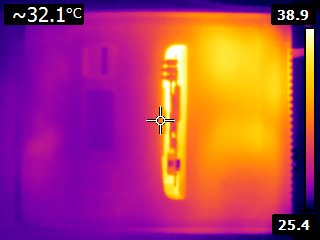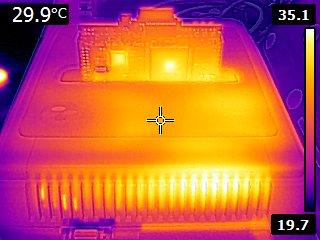sd2snes in heat
Just a little fun post inbetween. Ingo Korb of sd2iec fame (that’s the project that got me started on sd2snes in the first place!) had the chance to take thermal images of a running SNES+sd2snes. Some people, including myself, found that the sd2snes gets quite hot in the SNES. However the heat actually comes from outside the sd2snes, that is from inside the cart slot! The SNES’s linear voltage regulator produces a lot of heat that gets radiated into the cartridge slot (among other places).


These images illustrate it quite nicely. There are little hotspots where the chip dice are but most of the heat comes from below / behind.
That is impressive.
I think it is good that you do not only take care of the hardware and software part of the sd2snes but also of the consequences on the snes. I did not know that was the case.
Good work!
Thank you for not causing my SNES to melt or explode into little bits.
I’d love to see the same kind of shot with a SNES Mini/Jr. I wonder if it’s less prone to heat up or not.
You can lower the heat by using a DC power brick instead of the PAL region AC type.
Use about 8 to 10 volts and 1A or better 🙂
You can also swap in a DC/DC converter module with the same footprint as the original linear regulator
How much current is being drawn?
Around 120mA.
Maybe I should point out that the heat coming from the SNES is normal, it’s just due to the linear voltage regulator used by Nintendo. It turns all surplus power into heat in order to lower the supply voltage from 9-10V to 5V. That’s why it has quite a massive heatsink attached to it. That’s common practice for the day, the Mega Drive/Genesis uses the same part (or an equivalent). Even today linear regulators are used where power efficiency isn’t crucial or there’s not much voltage drop to be expected, or the use of a switching regulator is deemed impractical… Read more »
I would think that it’d be easy (and cheaper) to take a 5V 400mA DC adapter, wire in an SNES plug, and bypass the 7805 regulator entirely. There’s no reason to waste half of the SNES’s power draw to heat, and it would probably be better for the system as a whole. Throw a cap or two on the 5V line for smoothing, and bob’s yer uncle.
Actually the SNES’s audio amp needs 9V DC, otherwise the output waveform is clipped. See http://problemkaputt.de/fullsnes.htm#snespowersupply
Today, I’ve replaced the linear voltage regulator used by Nintendo by a R78B5.0-1.5 by RECOM – very nice: no extra cooling is needed for that device and it is very efficient. Unfortunately, it is quite expensive (~10€) compared to ‘normal’ DC/DC converters, but I love my SNES sooooo much <3
*Ouch* – found out today, that the new DC/DC-converter does not allow the SuperCIC-lock and -key go into pairmode O.o… So I build in back the good old Nintendo one 😛
Wat o_O How is that even possible?
Whoops – a missing cap was the reason why it didn’t work. Now it does the job with the Recom ^^
I don’t know where the problem was. Maybe also the fact that I use cartslot pin 56 instead of cic pad 7 as the clocksource for the scic-lock plays an important role… Nevermind 😉 My secound (and last) try will be this DC/DC-converter here: http://www.mouser.com/ds/2/281/oki-78sr-56393.pdf 🙂
works ^^
Were those thermal images taken with a Flir Ex-Series TIC? I have an E4 (that has been hacked in software to be an E8) and the interface looks very similar.
I am currently waiting for my SD2SNES to arrive from Stone Age Gamer (Deluxe Edition) and I will have to take some comparison thermal images between it and a standard cart.
Any progress updates on getting SuperFX implemented?
So, in noticing this heat build up myself and not being very technical (I found this page as I was worried about the heat!) Should I be worried or is the heat build up not an issue?
The post was to show that it is not an issue. 🙂
Who’s making the first water cooled mod for the SNES? 😉